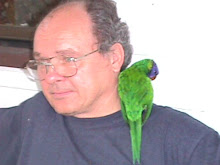 Most backyard birders tend to concentrate on the species they see and/or hear; it adds to their tally. Fay and I are among that league. Certainly we are always pleased to add a new species to the list but also enjoy the continual return of old favourites.
Most backyard birders tend to concentrate on the species they see and/or hear; it adds to their tally. Fay and I are among that league. Certainly we are always pleased to add a new species to the list but also enjoy the continual return of old favourites.There are however those species that seem to be dotted around the immediate vicinity of Allen Road but have yet to be recorded anywhere along the street; those missing in action.
The core niggle is not the rarities, as itemized on the Department of Environment &Resources Management official Wildlife Species List for the South Burnett region. We congratulate those fortunate birders who have recorded such gems as: Black-throated Finch Poephila cincta [according to the List last sighted in 2003]; Painted Honeyeater Grantiella picta [circa 2002]; Sooty Owl Tyto tenebricosa [last sighted in 2007]; Swift Parrot Lathamus discolour [last seen as long ago as 1994]; Coxen’s Fig-Parrot Cyclopsitta diophthalma coxeni, a subspecies of the Double-eyed Fig-Parrot [1966];
Nor would we expect regular sightings of species such as Paradise Parrot Psephotus pulcherrimus, lasted recorded in the South Burnett region at the end of 1915 but now generally presumed to be extinct throughout its former ranges. Nor would we expect the Grey Falcon Falco hypoleucos to suddenly put in an unexpected appearance, given that it was last seen in the region in 1908. And while the ever-elusive Red Goshawk Erythrotriorchis radiateus remains a distinct possibility, we will not be holding our breath in anticipation – they can range over territories in excess of 200km2.
Allen Road has had its moments, or at least it has since Fay and I first began recording the local birds back in April 2001. Indeed, as early as 3 June 2001 we were fortunate enough to have crippling views of Black-chinned Honeyeater Melithreptus gularis; it was still here a week later [11 June] and while it has never been here again since, it was recorded in the general South Burnett region in November of that same year. Ours must have been among the last seen hereabouts.
The near threatened Square-tailed Kite Lophoictinia isura was noted flying over our property in March 2008. The Powerful Owl Ninox strenua, listed by the Department as vulnerable, was heard distinctly calling from a little west of the house in October 2008.
No, it’s not the megaticks that concern, they’re just part and parcel of everyday twitching. Our puzzlement remains with the lesser species, those that we have recorded on a regular basis from only a few kilometres away but which have yet to appear on our Allen Road Backyard List.
Take the finches. Our only Allen Road record is of the Double-barred Finch Taeniopygia bichenovii. Indeed, it has nested in our orchard. However, a mere five kilometres away, along Berlin Road, we have recorded both the Red-browed Finch Neochmia temporalis and Zebra Finch Taeniopygia guttata. The habitats are not that dissimilar. Why have they not taken the step across to Allen Road?
 Both the Little Anthochaera chrysoptera and Red A. carunculata Wattlebirds have been recorded in the wider South Burnet region but not along Allen Road.
Both the Little Anthochaera chrysoptera and Red A. carunculata Wattlebirds have been recorded in the wider South Burnet region but not along Allen Road.However, of most concern to Fay and I remains the humble robin, any robin! Our birding friends Colleen and Robert Fingland, who, as the [Torresian] crow flies, live no more than a few kilometres from us on ten hectares, have both the Red-capped Petroica goodenovii and Eastern Yellow Eopsaltria australis Robins on their backyard list. We have recorded the latter along Berlin Road.
 The Department’s Wildlife Species List records no fewer than eight robin species for the South Burnett: Eastern Yellow Robin; Hooded Robin Melanodryas cucullata; Jacky Winter Microeca fascinans; Scarlet Robin Petroica boodang; Red-capped Robin; Flame Robin Petroica phoenicea; Rose Robin Petroica rosea and Pale-yellow Robin Tregellasia capito.
The Department’s Wildlife Species List records no fewer than eight robin species for the South Burnett: Eastern Yellow Robin; Hooded Robin Melanodryas cucullata; Jacky Winter Microeca fascinans; Scarlet Robin Petroica boodang; Red-capped Robin; Flame Robin Petroica phoenicea; Rose Robin Petroica rosea and Pale-yellow Robin Tregellasia capito.No robin has yet been recorded along Allen Road in the time that Fay and I have been monitoring the local species. Why?
We can accept the absence of the Hooded Robin; it is a species associated more with drier habitats and no doubt sighted on the western reaches of the South Burnett. The absence of Jacky Winter is also understandable; in our experience it prefers more open woodland, wider paddocks and country roadsides. The South Burnett must be close to the northern range limits of the Scarlet Robin. The same would appear to hold for the Flame Robin. The Pale-yellow Robin prefers skulking in rainforest habitats
However, what of the Rose Robin? We have enjoyed fantastic view of this species only 40km south at Emu Creek.
But the bottom line, the pain, remains the absence of the Red-capped and the Eastern Yellow Robins. They are dotted all around us but continue to resist putting in an appearance along Allen Road.

Image via Ákos Lumnitzer @ amatteroflight.com

No comments:
Post a Comment